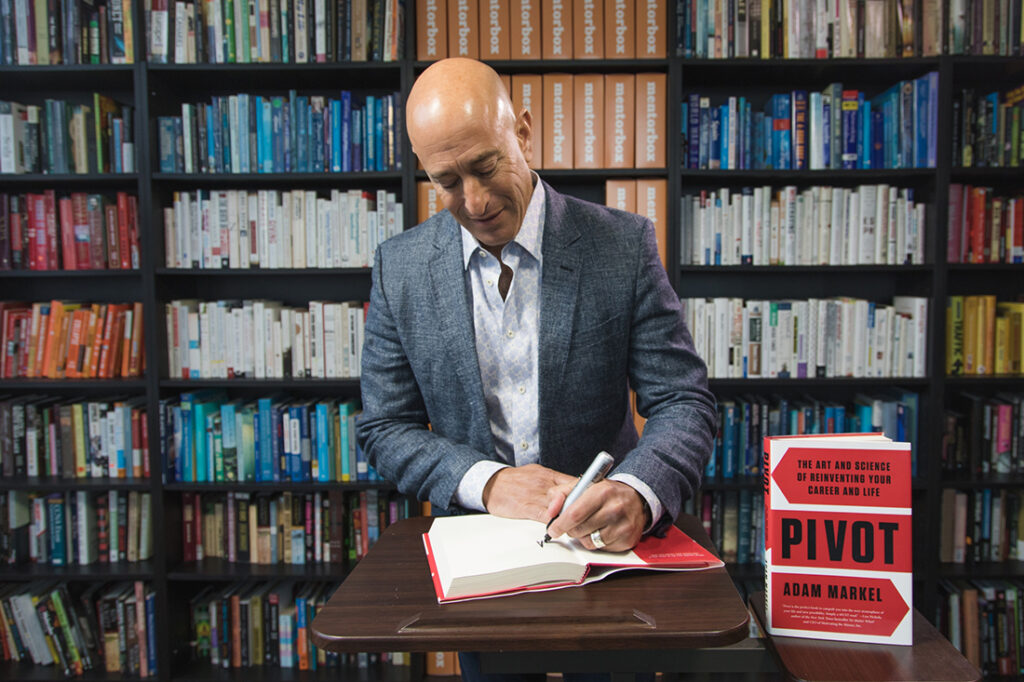A career pivot is one of the most intimidating things you can do, especially when you’re considering leaving a career in which you are firmly established. Perhaps you’re not even sure if pivoting is the right move, or if it is, you’re not sure how to prepare for it or what bumps you’ll encounter along the way. Here’s how to make a successful career switch, according to experts.
How do you know if you need to pivot?
The first hurdle is identifying whether a career pivot is the right step to take. Business psychologist and coach, Nicole Samuels-Williams, has undergone a career pivot of her own, from marketing into her present space. In her practice, she has seen clients experience the same feelings she did: stagnant, bored and a sense of having plateaued. “That is definitely an indicator that we need to grow.”
Adam Markel, keynote speaker and author of Pivot, has also switched careers several times, with a change from law to his current role, describing his previous career as feeling like “[his] heart or soul was dying as a result of what [he] was doing with [his] days.” He advises self-diagnosis, looking for the symptoms and what your body, mind or heart might be telling you. “It might be agitation, anxiety, trouble sleeping, anger… how does that all make you feel? Are there signs that something is… not the way you want it to be?” Markel explains that you can’t become unaware of those issues once you know they are there.
How can I prepare before making a career pivot?
A pivot is seldom something undertaken overnight. There’s a great deal of preparation required to make a smooth transition. Samuels-Williams advises a deep assessment of the market, evaluating trends and looking for emerging opportunities, then crossing that with a consideration of personal strengths in terms of qualifications, skill sets as well as genuine interest and consulting your internal compass.
“You don’t want to pivot and do something you’re passionate about, but nobody’s going to pay you for it,” she says. She also encourages using other people to identify your strengths, even if you cannot see them within yourself. “If… people are coming to you for advice or… to solve a particular problem over and over… maybe they’re seeing something in [you] that [you] don’t see in [yourself].”

Markel recommends looking before leaping, unless you are in an abusive workplace. “Plan your pivot… your Plan B. Don’t leave your Plan A until Plan B is up and running. That means you have to work Plan B simultaneously with Plan A for some [time].” For him, that meant balancing both for a period of almost two years, but it was ultimately worth it.
Samuels-Williams also encourages learning and development and investing in upskilling. She explains that formal academic education isn’t necessarily the solution. Rather, she encourages experiential learning, such as apprenticeships or internships. “There’s always formal education, but try to link up with somebody who you can shadow to see how it really works.”
What problems can I expect during a career pivot and how can I handle them?
Markel says fear is inevitable while making major life changes and uses an analogy of a car driving at night with headlights. “You can’t see a mile ahead of you. You can only see a certain distance and you’ve got to be OK with that… you have to have faith that the road will reveal itself… that you won’t run off a cliff. The worst of our imagination comes to life in our fears.”
Samuels-Williams believes the key is learning to reframe things not going well as data points, rather than failure. “Here’s another thing I now know does not work, so I’m just adding to my wisdom box… there’s a very steep learning curve.” She also cautions against our nature as creatures of habit, where we are tempted to go back to what we know we’re good at. “In those moments of uncertainty, the easiest thing is to go back rather than push through.”
Experiencing naysayers is likely an inevitability, so Samuels-Williams advocates fostering mental resilience and surrounding yourself with like-minded people. “You need to have other people around who have gone through the same thing to say ‘Hey, it’s just a phase. Keep moving, keep going.’ [Have] the humility and courage to ask for help.”
Markel also emphasizes resilience, describing it as the “common denominator in outperforming problems… mentally, emotionally, physically and spiritually. The most important work we do [is done] in the privacy of our own hearts, so it’s an inside-out solution… you will make better decisions and ultimately things will change for the better.”
How do I know if my pivot was a success?
Samuels-Williams believes tracking progress is essential and advises those pivoting to identify milestones or KPIs before making the pivot to ensure you’re working toward what you deem success to be, especially since success looks different for everyone. For some it’s financial, for others it’s having more autonomy or being more creative. She explains that when we make a career pivot, we are designing more than just a job; we are designing a life at the same time, deciding what lifestyle we’re truly pursuing.
Markel says the best way to assess the success of a pivot is to complete the same symptom check described above and determine if you feel physically and emotionally healthier. If it feels difficult to assess, external help may be key, such as a therapist rather than friends or family, since sometimes we don’t get the best advice from those closest to us. “Sometimes people don’t want people to change because of the fear around it… because that creates unknowns for them as well.”
Markel also says it’s important to not regard every pivot as the final one. A pivot may be enough to get you from Plan A to Plan B, but Plan C may be the eventual goal. “You pivot throughout your life,” he says.
Photo courtesy Adam Markel











